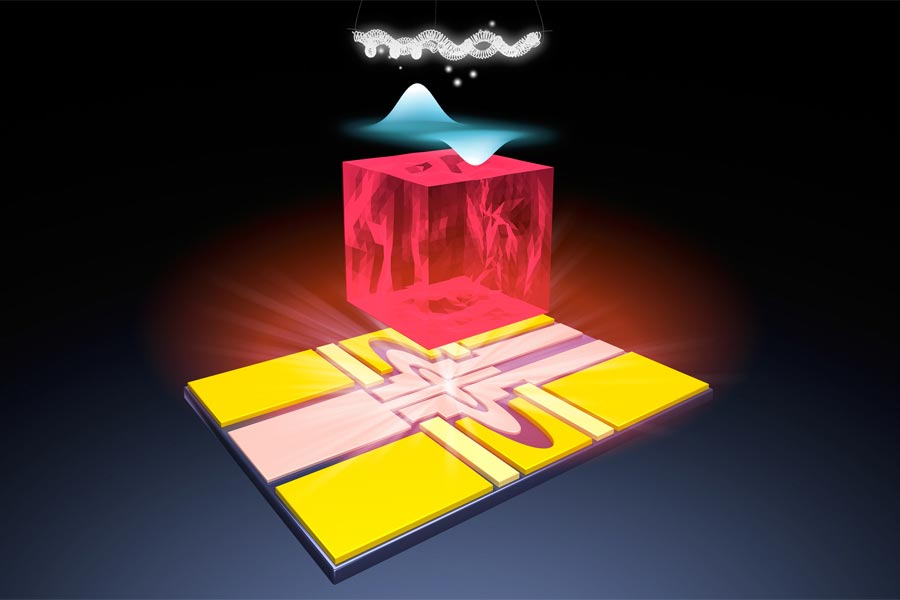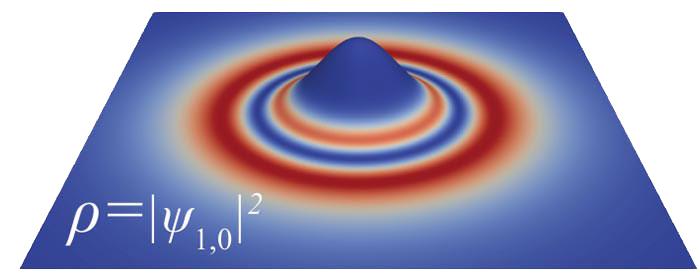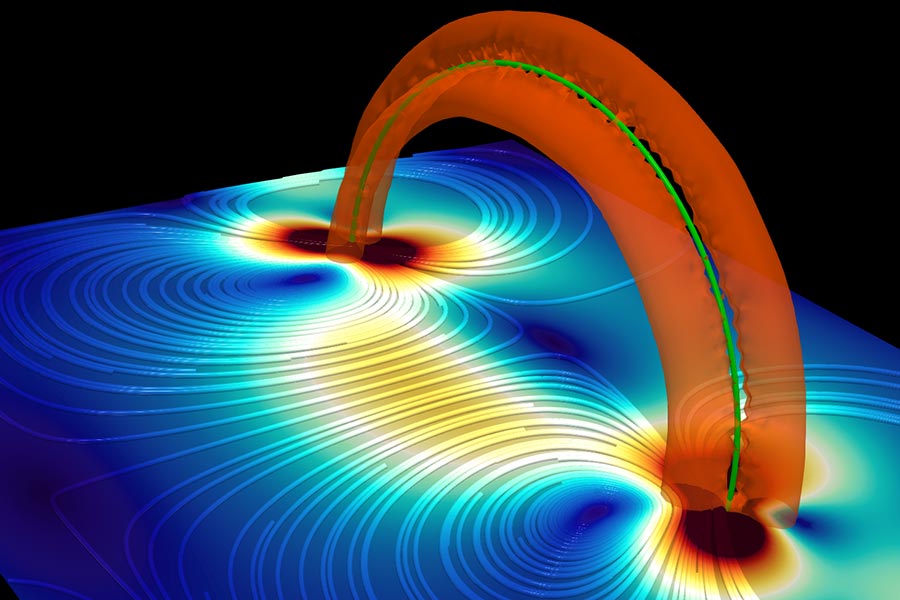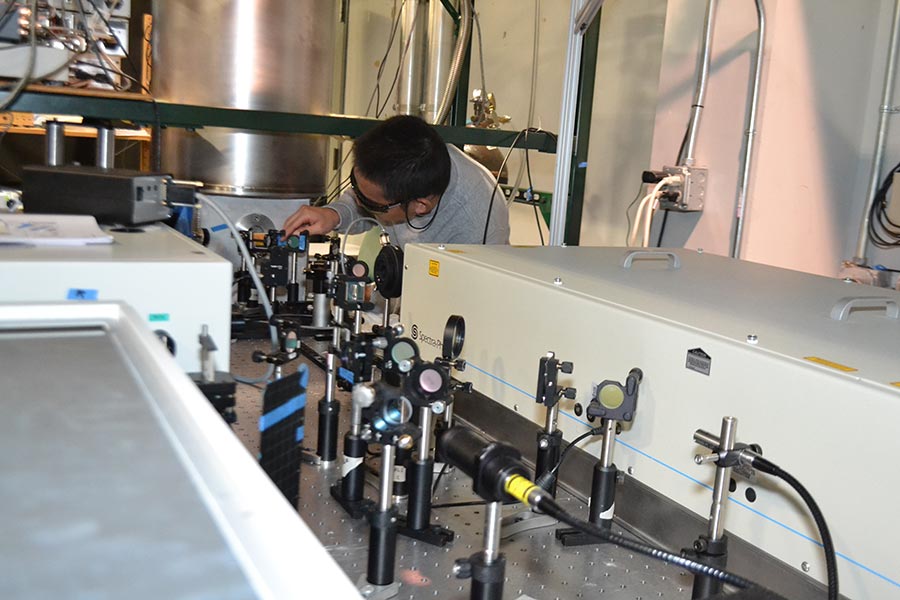
Dr. Wei Guo, Professor
Mechanical Engineering and NHMFL
Education and Training:
- 2002: BS in Physics, Wuhan University (China)
- 2008: PhD in Physics, Brown University (with Humphrey Maris)
- 2008-10: Postdoctoral Scholar, Yale University (with Daniel McKinsey)
- 2010-12: Research Scientist, Yale University

When did you join FSU? What made you choose your university to build your research program?
I joined Florida State University in the summer of 2012. Prof. Steven Van Sciver, a FAMU-FSU Mechanical Engineering faculty member and a world-leading researcher in helium cryogenics, informed me about an available faculty position. My role was to continue the operation of his cryogenics lab at the MagLab after his retirement. I was well aware that the Van Sciver lab had world-leading facilities for quantum fluids research, presenting a fantastic opportunity for me. Besides, I was very much attracted by FSU's unique resources, particularly the MagLab's provision of liquid helium and technical support on cryogenics and superconducting magnets. The presence of classical fluid experts at FCAAP offered collaborative and learning opportunities beneficial for my quantum fluids research interests. These resources were crucial for my research needs, making my decision to join FSU straightforward.

When did you become interested in quantum research? Who or what inspired you?
While working as a postdoc at Yale, I was captivated by Prof. Robert Schoelkopf’s pioneering work in superconducting qubits and quantum computing, which sparked my lasting interest in this innovative field. My research journey in quantum fluid dynamics, particularly focusing on the intricacies of superfluid helium and Bose-Einstein condensates, continually nudged me towards the quantum science frontier. The concept of single electrons trapped on superfluid helium was among the first few systems proposed for quantum computing, yet the lack of clear qubit operation of this system made me cautious about venturing into this domain. A turning point arrived in 2022 when my collaborator, Prof. Dafei Jin from the University of Notre Dame, replaced superfluid helium with solid neon, demonstrating that single electrons on neon surfaces could function as charge qubits. This new system exhibits exceptionally long coherence times, surpassing all conventional charge qubits and aligning with the performance of top-tier superconducting qubits. This landmark discovery, which we co-authored and published in Nature, reignited my passion and curiosity in quantum science, prompting me to dive deeper into this field. Recently, with my student Toshiaki Kanai at FSU, we conducted a theoretical analysis of the quantum states of electrons on neon surfaces. Our study unveiled that electrons could naturally bind to surface bumps on neon, creating distinctive ring-shaped quantum states. This novel insight could demystify some enigmatic observations from Prof. Jin’s experiments. Our findings will be published soon.

What are your current research interests? Could you give an example of some recent result that you feel especially passionate about?
My research encompasses quantum fluid dynamics, helium-based dark matter search, cryogenic accelerator physics, quantum-fluid-based qubit research and development (R&D), and liquid hydrogen aviation. Among these areas, I am particularly passionate about quantum fluid dynamics research, for which my group has gained international recognition, and quantum fluids and solids based qubit R&D. In fact, my contributions to the field of quantum fluids led to my election as an APS Fellow in 2023.
A highlight of our quantum fluids research includes the groundbreaking direct visualization of quantized vortex rings in superfluid helium. This achievement allows us to quantitatively determine the dissipation in a superfluid, providing a basis to accurately assess which theoretical model best describes dissipation in superfluid helium. This work was published in Nature Communications. In addition, another notable project is the e-neon qubit research, a collaborative effort with Prof. Dafei Jin, which was published in Nature. Additionally, I am thrilled about the upcoming publication of the theoretical work my student Toshiaki and I have completed, which promises to contribute further to the exciting topic on e-neon qubit platform.

How would you describe your research to general public? Why is your topic important?
My research delves into the realm of quantum fluids, a term that might sound like something out of a science fiction story, but it's very much a part of our reality and has some amazing applications. One of the stars of my research is superfluid helium. Imagine a liquid so cold, just a couple of degrees above the absolute zero temperature. At this chilly point, helium transforms into a superfluid, a substance that flows without any friction. It's like a liquid superhero, defying the normal rules of physics. Now, you might wonder, "Why should we care about this super cool superfluid?" Well, superfluid helium is a game-changer in how we manage heat in some of the most advanced technologies we rely on today. It's used to cool down the giant magnets in the MagLab, one of the world's leading facilities for magnetic research. These magnets are crucial for studying materials at the atomic level and can only work correctly if they are super cold. But that's not all. This superfluid helium also plays a crucial role in cooling down particle accelerators, which are massive machines that help scientists understand the fundamental particles of our universe. It's also key in the medical field, keeping MRI machines operational, and it even helps in space exploration by cooling satellites and superconducting power transmission cables on Earth. In the last few years, the story has gotten even more exciting because superfluid helium, along with other quantum fluids and solids, has started playing a pivotal role in the quantum technology revolution. We're talking about the building blocks of future quantum computers (qubits), ultra-sensitive quantum sensors, simulators that can model complex quantum systems, and detectors that can spot elusive particles. This research is at the forefront of the quantum age, breathing new life into the field of quantum fluids and solids and potentially leading to breakthroughs that can transform how we live, work, and understand the universe around us.

What do you think about the future of quantum research? How can FSU contribute to that future?
Quantum research represents the future of science and technology. Many leading universities and national laboratories have established significant research centers dedicated to Quantum Information Science and Engineering (QISE). Despite this national trend, Florida has yet to establish its own dedicated QISE center. As a premier institution in the state, Florida State University (FSU) is ideally positioned to lead the charge in becoming a beacon for QISE research, education, and innovation. With numerous QISE centers emerging nationwide, it is imperative for FSU to carve out a distinctive niche that not only distinguishes it from existing programs but also cements its status as an innovative leader in the field. The untapped potential of quantum fluids and solids (QFS) in QISE research, and the current absence of a comprehensive QFS-based QISE center program nationally, provide FSU with a unique opportunity to lead. Championing this initiative and advocating for the establishment of a QISE center at FSU will be a key focus of my future efforts.
What are your interests outside of research? What do you like to do in your free time?
I enjoy playing billiards and biking with my kids. My free time is quite limited currently. When I do find some, I prefer to relax by watching movies with my family or cooking traditional Chinese cuisine for them.

